In the United States alone commercial dishwasher manufacturing has a market size of $893 million dollars. (Source)
Big Business.
I wanna let you in on:
So you don’t end up with something like this.

Bonus: I will also share with you, The 51 types of food-service operations below.
When done reading this you’re going to know how to make the right choice according to your operation.
A shout out to my friends at Comenda and Andrea Genoni who helped make this article happen.
But before we start there’s one thing we have to get out of the way.
Sometimes dishwashers can also be called warewashers.
The word warewashing comes from washing dinnerware, flatware, glassware, thus ‘ware’.
Dishwashing and Warewashing are both the same.
With that, let’s move forward.
Types of Commercial Dishwashers
There are 8 types of dishwashers for commercial purposes.
- Undercounter glasswasher
- Undercounter dishwasher
- Hood or Door type
- Rack or Conveyor type
- Flight type
- Tray Washer
- Pot washer
- Utensil Washer
So let me tell you what differentiates each one.
Undercounter Glass-Washer
Pretty much self-explanatory, glasswashers are purposed to be either at the bar or in the kitchen.
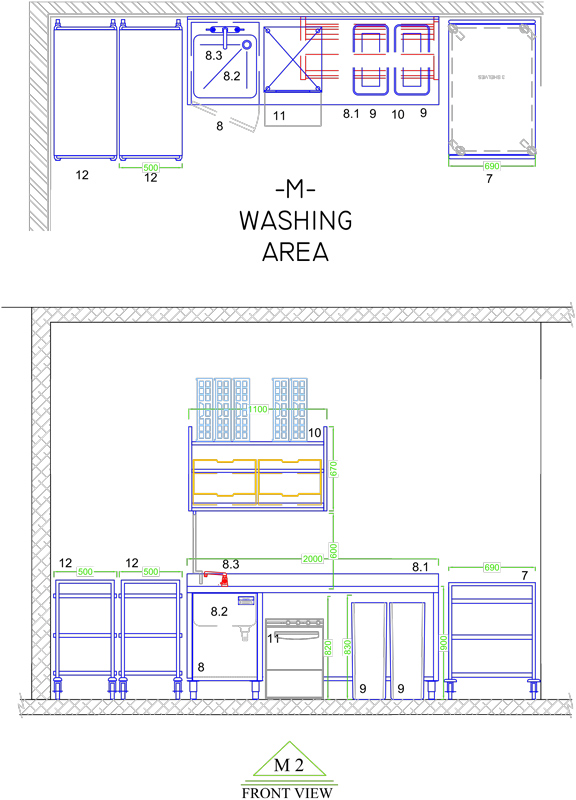
They are front loading and usually have a clearance of 27-28cm.
You can wash all types of cups, tall wine glasses and even high stem champagne glasses as they are usually 20-26cm and can fit into the machine.
There are two different size washers, washers with racks 40x40cm and 50x50cm.
The machine and the technology are the same.
Washers that fit a 50×50 rack just wash more then the latter.
With both, you have the opportunity to wash dishes, cutlery and even trays.
This is because different programs make it a multipurpose washer (new generation machines).
Instead of having a program just with time, you have temperature, length and other functions you can structure.
An under counter glass-washer usually has a capacity of 30 racks per hour.
With a 40×40 rack you can clean approximately 25 cups per load.
With a 50×50 rack you can clean approximately 36 normal cups or 49 small cups.
Undercounter Dishwasher
A common misconception is that under-counter dishwashers are meant to only wash dishes.

However in this machine, you can wash the same things as a glasswasher.
In under-counter models (unlike conveyor or flight type washers) you can’t mix glasses/dishes/cutlery together.
Want to know why?
In a typical household washer, there is a damper that drains the water with each rinse cycle.
That’s why you can put all your ware together.
But it takes much more time to complete the entire cleaning cycle which isn’t suitable for a food-service operation that relies on speed in service.
In a commercial machine, you win time.
Only if you purchase a water damper that drains the water tank with each wash will you be able to cram everything in together.
But I wouldn’t recommend it because of the residue and grease that differ from glasses to dishes or cutlery.
If you don’t purchase a damper you would need to wash cups alone, dishes alone and then drain the water tank.
There is also the water temperature that will be different for both.
Other then clearance and speed, new generation glasswashers and dishwashers are the same.
Dishwashers have a front-loading clearance of 36-40 cm.
An under-counter dishwasher usually has a capacity of 20 or 30 or 40 racks per hour depending on if you have the machine on energy savings mode or not.
Typically each rack fits 18 dishes.
Hood Type Dishwasher
With a hood-type dishwasher you can wash plates, cutlery and cups simultaneously.
These are powerful machines with a rinse arm above and below the rack.
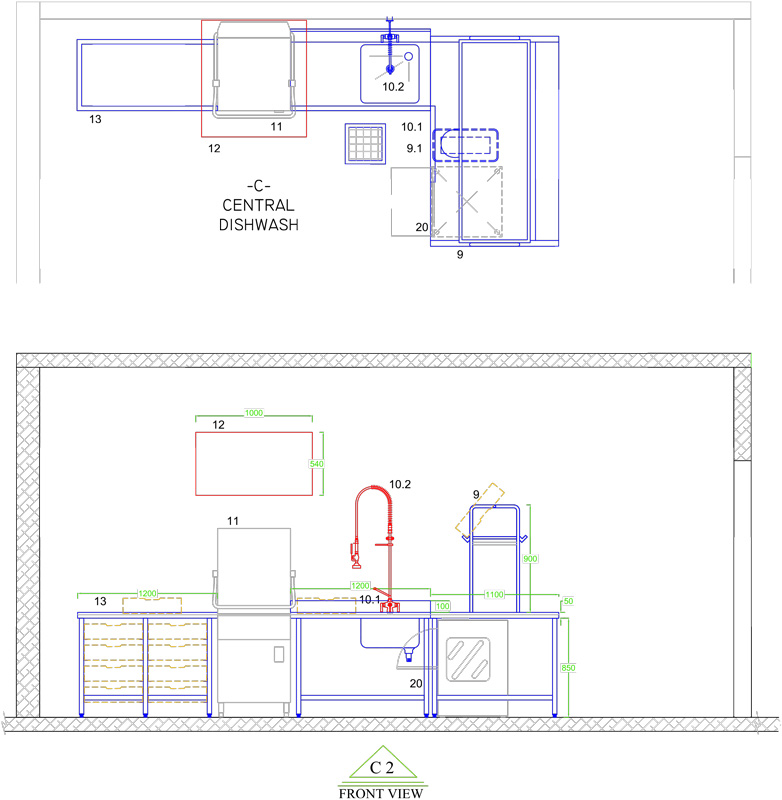
Hood type dishwashers will almost always have a condensate hood above the unit drop down from the ceiling to exhaust the steam build-up from inside the washer after the door is opened.
The hood type dishwasher DOES NOT come with a hood, you need to purchase that separately.
The hood above doesn’t have any filters because it sucks up steam and not grease.
If you don’t have a hood above the machine then you risk creating a hot environment in which you need to run more electricity to cool down the space from your Air Conditioning unit.
There are 2 main advantages of using a hood type dishwasher.
- Higher capacity for washing all your crockery.
- Ergonomic, set up allows an operator to multi-task while there is a load in the machine.
The disadvantage is that it needs more space.
They are designed to have a connecting table “Pre-wash” (meaning before entering the machine) and an “exit” or “clean dish table” for continuous operation.
It can be installed linear, or a corner type configuration.
The below graphic, thanks to Vresso shows a typical installment.

As you can see there is the following:
- Receiving table – this is where dishes or trays with the tableware is set and left overs disposed of in the garbage bin below.
- Pre-Rinse or connecting table – This is where the table and chinaware is rinsed off and set into the rack right before the dishwasher.
- Dishwasher – The rack should then slide seamlessly into the dishwasher. The unit is integrated into the dishwasher via a connecting arm done by your kitchen equipment supplier. (link)
- Exit or Clean dish table with rack under-shelf – Once completed in its cycle the rack is then again slid onward to be dried off. It’s advisable to have a rack shelf with angle ledges to hold the racks in the empty space below. This is also connected seamlessly and uninterrupted.
- Shining table with Shelf – If your operation is vigorous and you have the space you should have a shining table with shelving set on the wall to place the clean china, cutlery, utensils and cups.
These washers usually have a clearance of 44cm.
Capacity of 30 to 65 racks per hour depending on the model.
Some manufacturers have “ventless” hoods that allow the machine to be connected to cold water feed (15 to 30 deg C) and self condense the steam produced in the wash chamber during the selected wash program.
This eliminates the need for extraction hood above the unit which saves you money on air conditioning.
Rack or Conveyor type
This type of washer is for high volume.
The units are modular and assembled in a line, corner or double corner configuration.
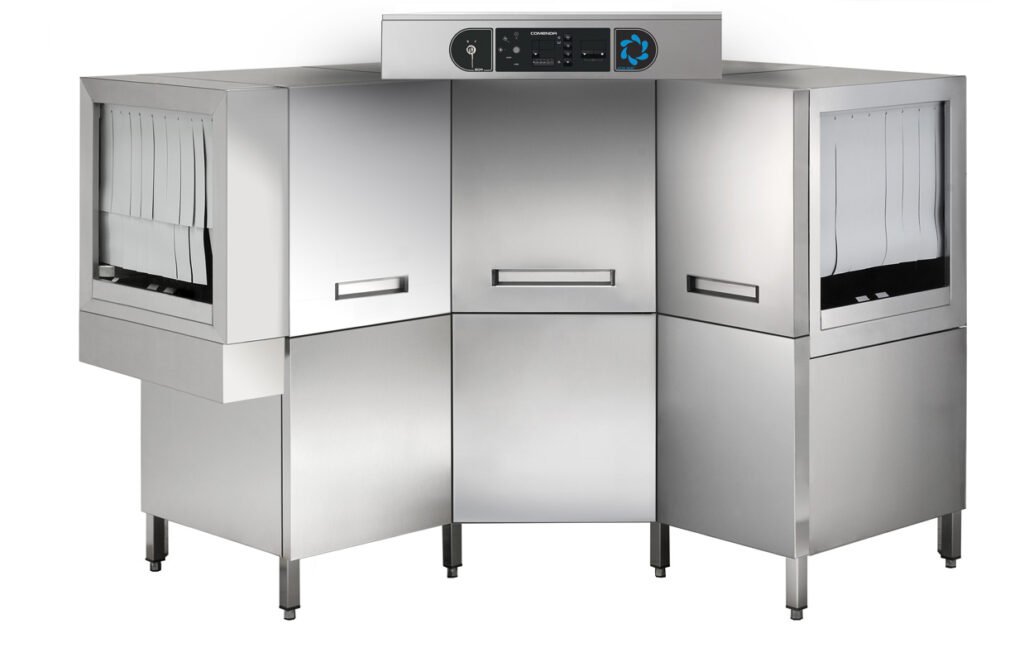
Units can usually wash from 100 – 300 racks per hour.
Rack or conveyor washers usually have a clearance of 43cm. You can wash every utensil, pot, pan, even crates, they are extremely flexible and can be modular for different applications.
Each operation should be programmed separately.
Mostly, these machines are custom ordered to fit as per operation requirements.
The best washers maximize the wash and minimize water consumption.
There are typically 4 stages to washing with conveyor washers.
A major difference between this washer and a hood type washer is wash in higher volumes in a shorter period of time.
Prescrap and manual prerinse are always recommended.
Flight Type Dishwasher
These washers are the heavy weight contenders.
Flight type dishwashers come on a continuous conveyor that doesn’t require a rack.
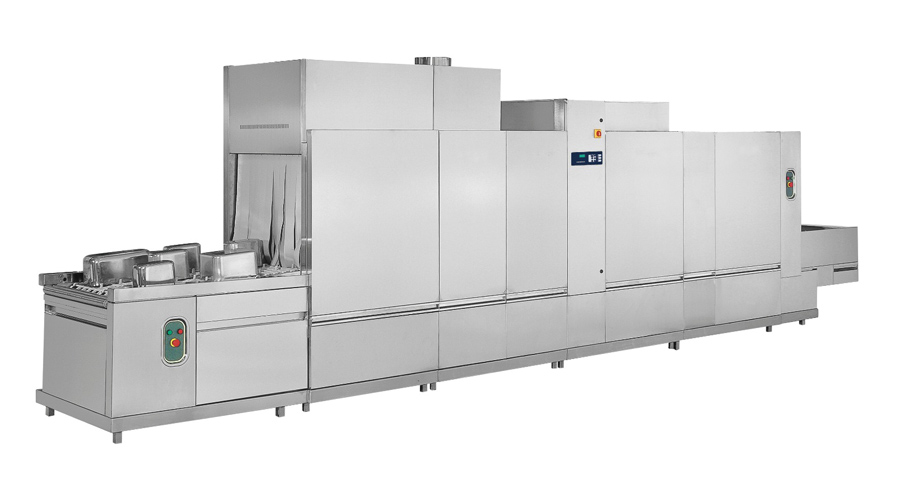
With a flight type machine, you also dont need to remove small food left overs on the plate like the conveyor washer.
Everything is loaded directly on the belt without a pre-rinse.
It is just recommended that glasses and cutlery be placed on racks.
Certain manufacturers also build out the machine with separate specific racks. (compartment racks and stackable racks are available on the market)
These machines are for large volume operations like hospitals.
They are appropriate with operations that have fix meal sets – again like hospitals or factory cafeteria’s and even catering operations to large construction sites.
Flight catering as well.
We’ll get more into the recommendations below.
The belt can be customized on what needs to be washed.
Clearance is 43cm and up to 63cm.
As a rack or conveyor type dishwasher there are 4 stages in the wash cycle.
- Prewash
- Wash
- Rinse
- Blower/Dryer
High level of customization to suit the specific customer requirements in terms of items, volumes and time are needed here.
Tray Washer
Tray washers only wash trays.
Trays for large staff canteens, in-flight catering operations and hospitals.

The important parts from this type of washer are:
- Trolley with trays to feed into the machine
- Magnetic silverware handler incase there are any silverware by accident – this will drop the silverware into a basked below the machine
- Tray unloader – at the end of the machine to unload trays without interrupting the operator
- Backup Tray accumulator – Stacks trays while operator replaces exit trolley tray
Tray washers have a capacity of 700 -1,500 trays per hour.
On most machines the trays are fed horizontally and not vertically.
The washer works like a tunnel machine.
They have a basic wash operation: wash and rinse with a heavy-duty blower dryer section to make sure that melamine and other hard to dry materials will come out perfectly dry and stackable, avoiding bacteria proliferation and contamination.
The drying section (blower) should have an option for double blower incase your trays are made from melamine which is a material that is harder to dry.
Pot Pan and Utensil washer
The pot washer will wash:
- Pots
- GN pans
- Bakery trays
- Grills
- Containers
- Utensils
- Perforated containers
- Containers
And anything that needs a tedious clean.
Meant to remove the toughest stains, grime, grease and cooked-on leftovers from the stainless steel.
There are 3 variations of this type of washer:
- Pot and Utensil Washer
- Container Washer
- Flight pot and utensil washer
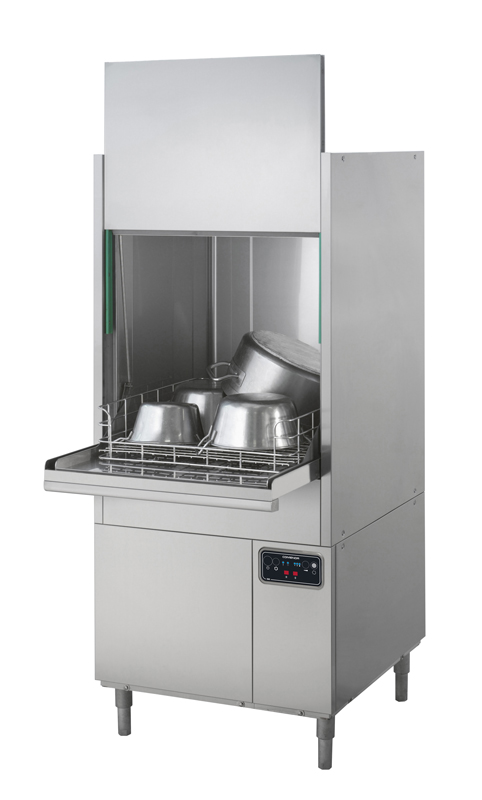
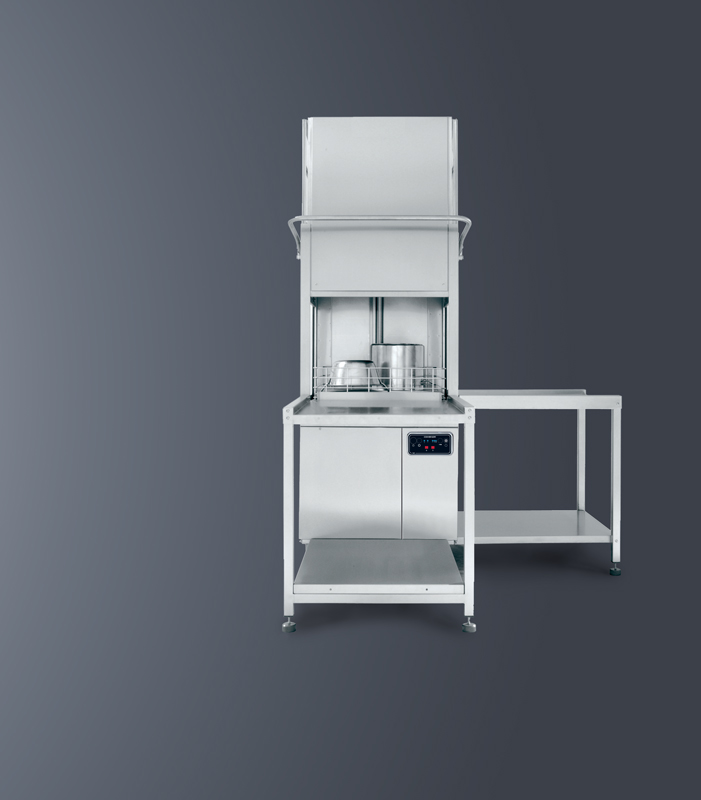
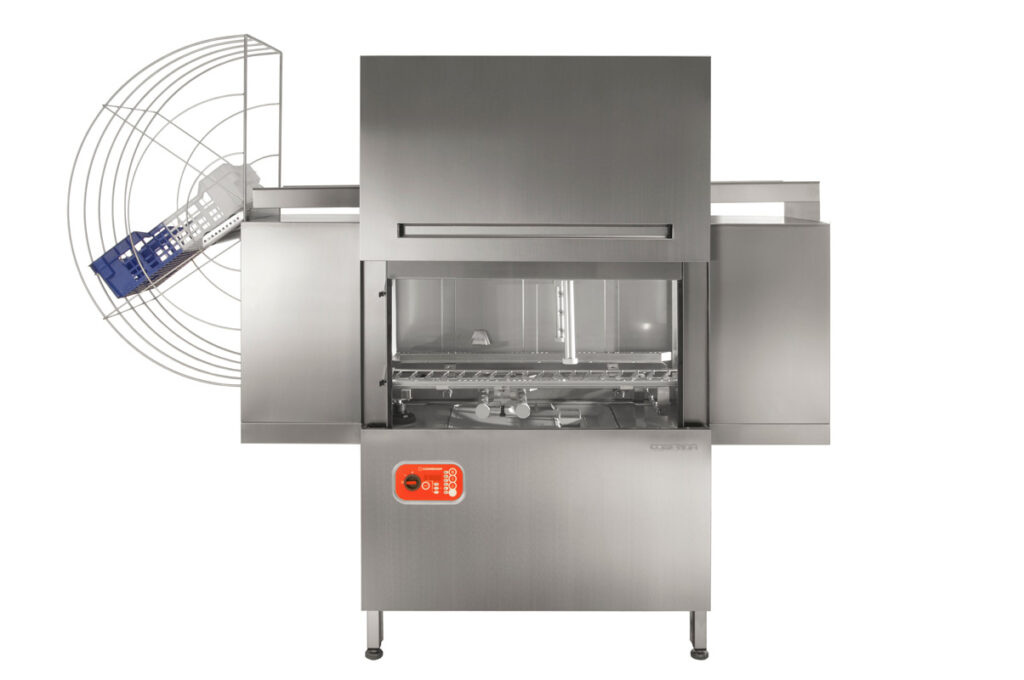
Pot & Utensil Washer
Washers usually have a clearance of 65cm – 80cm.
Wash cycle time ranges from 2-4-6-10 minutes.
Rack Dimension is usually 55 x 66 cm and 132 x 70cm.
They can be a standalone unit or side loading as part of a continuous feed.
Container Washer
Washers usually have a clearance of 43cm.
Wash cycle time is the same as the pot/utensil washer.
Rack Dimensions can be suitable for 50 x 50 cm or 50 x 60 cm. It will also intake a crate 42 x 60 cm.
The unit needs to be fed through a clean dish table and have an exit table for output.
Flight Washer
Washers usually have a clearance of 63cm.
Adjustable belt speed, between .4 to 1.8 meters per minute.
Belt width minimum 84cm.
The Wash cycle time is also the same.
Rack Dimensions is usually 132 x 70 cm.
Water Requirements for your dishwasher
Water quality is a key determinant in not only in the quality of your wash but the life of the ware washer.
Having poor quality water can also leave a bad smell on your cups and dishes.
Superlative washers heat up the water to 90°C.
At 90°C you will not only killed off most bacteria and residual grease or fat but at that temperature you’ll most likely getting a shinier cup/dish while having…well less shining to do.

Dishwashers will wash at a low temperature of 55°C degrees and then start a rinse cycle once cleaned at 85°C.
Temperatures are adjustable according to what you want to wash.
The water evaporates at 85°C and makes removing impurities easier.
We’ll get more into temperature later.
Two important parts to have great water quality is the water hardness and reverse osmosis system.
Hard water disrupts detergents to properly kill off food soil.
Leaves spots on cleaned items and causes limescale (calcium) deposits inside the dishwasher and most importantly the heating element.
The hard water should be tested so you don’t burn out the heating element within the machine.
If you have hard water you need to soften it.
This is done by replacing minerals in the water with water-soluble salts.
Water hardness is measured in grains per gallon or milligrams of calcium (Ca) per liter, or parts per million.
Degrees of Water Hardness
- Soft water 0-17.1 mg/L of minerals
- Slightly hard water 17.1-60 mg/L of minerals
- Moderately hard water 61-120 mg/L of minerals
- Hard water 121-180 mg/L of minerals
- Very hard water more than 180 mg/L of minerals
Here is a more visual version

Reverse Osmosis systems can also help expand the lifespan of your dishwasher.
In an RO system the minerals and soluble salts in hard water are removed.
The RO unit is a membrane filtration system that retains almost all the extraneous substances.
What is the correct temperature for a commercial dishwasher?
Commercial dishwashers have a tank which provides hot water at a temperature ranging from 43°C to 60°C.
There are Low-Temperature dishwashers and High-Temperature dishwashers.
With Low-Temperature washers:
- You will have energy efficiency
- You will use chemicals to sanitize your ware
- Will not have much steam production
- Will not warm glasses served if your operation serves directly after washing
With High Temperature washers:
- Hot water above 90°C will sanitize the wares
- Faster wash cycle and super dry once removed
- Removes grease and grime better
- Needs a booster inside or outside the machine
The water booster can be integrated within the machine or an external unit separately.
That’s in-case your dishwasher doesn’t reach that level of temperature or you have a problem with hot water reaching the machine.
In high temp machines after washing the 90°C water is injected during the final stage of which is rinsing.
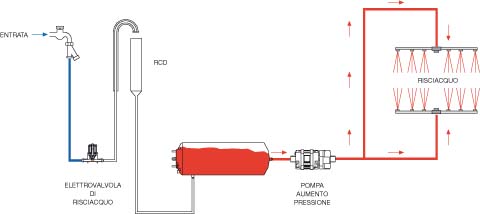
Depending on your location there are different temperature requirements.
According to NSF standards, the temperature has to be at least 120°F or 48°C.
Anything below that temperature creates a risk:
- Leaving grease or grim on the rack which gets transferred to the dish or cup
- Impurities on the dish or cup
More on the temperature requirements can be found here.
Now lets move onto choosing the right dishwasher.
How to choose a commercial dishwasher
To know what type of dishwasher you need, there’s something I’d like to introduce OCM.
OCM stands for 3 abstractions.
In any foodservice establishment if you can answer all three of OCM it will guide most of your decisions which are:
- Operation
- Cuisine
- Management and Control
I will cover each one of the above and its application right below.
Here are just some typical questions you can come along:
- What type of uniform shall I have?
- What type of manager does my operation need?
- What capacity dishwasher do I need?
So, now lets start with the first one and explain.
Operational Analysis
There are over 51 types of food-service operations.
In order to know what type of washer you need, you’re going to know what your operation is.
In a hospital you most likely won’t need an under-counter glasswasher, those are for bars and restaurants.
Also, you will most likely (depending on how many beds) have a larger capacity of washware including utensils and trays.
Undercounter units might be installed in different hospital wards where thermo disinfection might be required.
This depends on the local legislation and varies from country to country.
So, you’re going to choose a much larger machine and will not require an under-counter.
A lot of these assumptions are intuitive.
In a bar you won’t need a hood type dishwasher because it will be over capacity (depending on how many cups and seats you have and requirements other than cleaning cups).
Unless….
It’s a very large bar.

Is your operation fast food only with trays needing washing and no cutlery dishes or glass, or is it take-away only?
Which leads us to capacity analysis.
You need to have an idea of:
- How many seats you have (or how many meals you presume to sell in a shift)
- Approximately how many servings there are in the day vs working hours (employee shift and wash cycle)
- How many dishes, cutlery or other ware you will be washing
If you can answer ALL of the above considerations then you can make the right choice with the above types of dishwashers presented.
Now let’s move onto Cuisine.
What is your Cuisine
Just like social institutions that created culture.
Cuisine is social culture.
Fast food shops serve on plastic trays and paper wrapped products with carton cups mostly.
Fine dining does not.
Mediterranean food is otherwise known as “meza” has MANY more dishes to wash per person then fine dining.


For example in Mediterranean culture for every seat there a minimum of 4 plates and 4 cutlery along with 2 glasses.
Multiply that by the number of seats there are, and soon enough you get what I mean.
Then calculate how many racks need to be washed and you’ll know what type of machine you need.
Make sure you know your cuisine, along with what your operations is and how many servings you have.
With that, let’s move onto the last consideration.
Management and Control
Leadership is a big word.
There are 4 basic leadership styles you can find yourself within your organization according to Ana Margarita Olar written in this well laid out article.
I mention this article as its common among almost all foodservice establishments and you can relate to each style no matter where your position stands in the organization.
The styles are:
- Autocratic
- Democratic
- Consultative
- Laissez Faire
I won’t go into the details of each style, you can read more on that here.
However, what I can say that relates to this piece is that you have to know how your operation is run.
Once you know how you will operate, then you’ll know how to make the right decision.
Next
Control, how will you set responsibilities?
Here are some responsibility characteristics:
- Who’s responsible for things to get washed
- Who’s responsible if something gets broken
- Who’s responsible if something gets stolen
- Who’s responsible if something is delivered late
- Who’s responsible if something isnt cleaned properly
You need to set out the responsibilities according to your management (or leadership) style consand then set the control parameters for accountability.
Commercial Dishwasher companies
Here is a list of world renowned dishwasher manufacturers.
Conclusion
You made it to the end.
You now have the right knowledge to make actionable decisions if you own a restaurant, want to know how to choose the right machine or if you work in any foodservice operation.
I hope this guide helped you.
Anything missing in this article?
What remarks do you have to make, feel free to leave them in below!
ALSO, GO AHEAD AND TAKE MY POLL!









